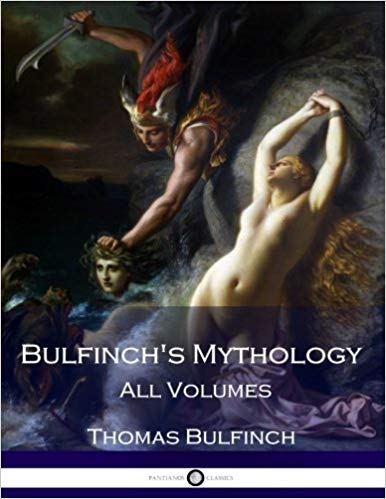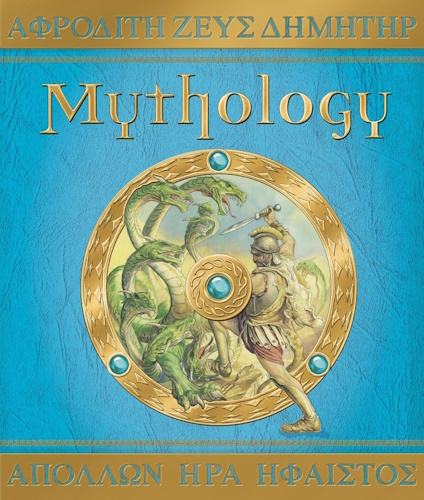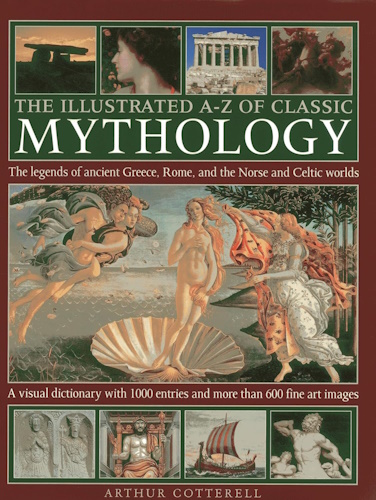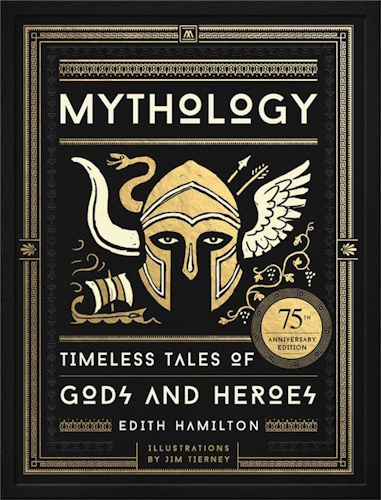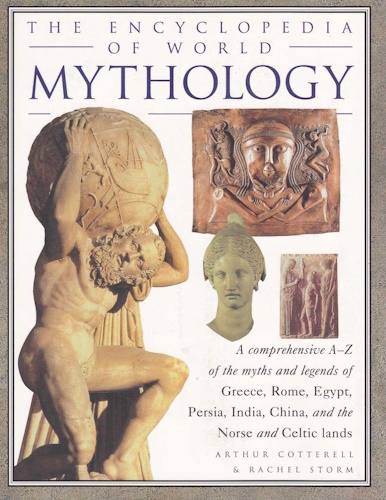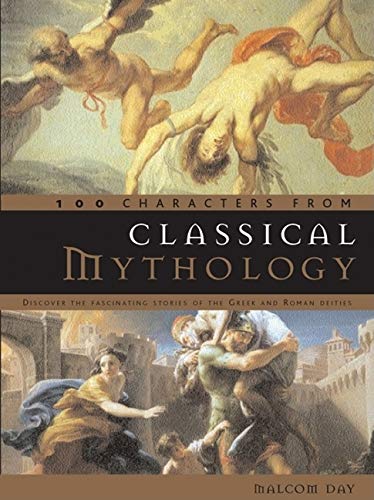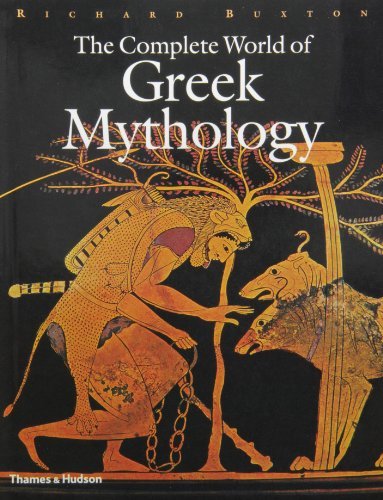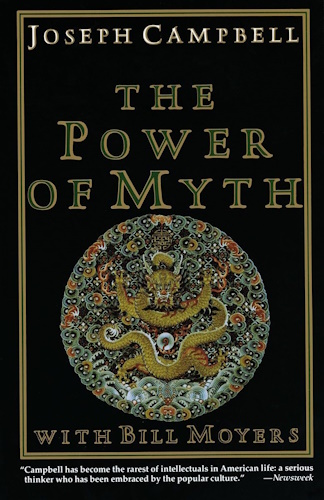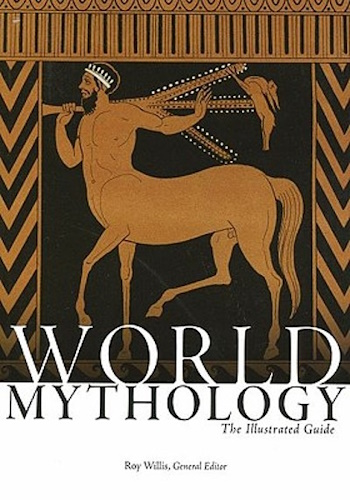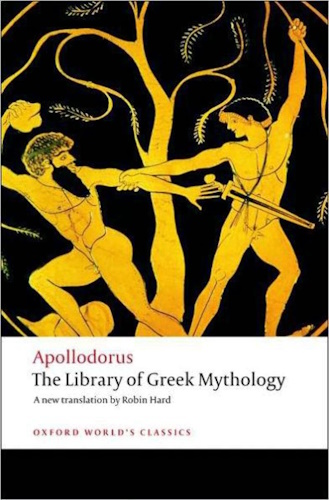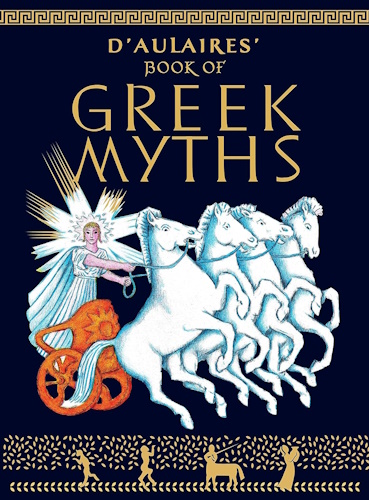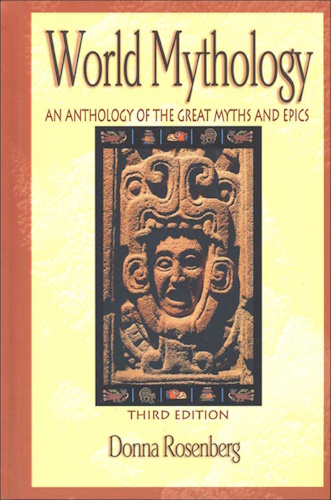
![]()
![]()
Part I.
King Arthur and His Knights.
Chapter XI.
Tristram and Isoude.
AFTER this affair Tristram was banished from the kingdom, and Isoude shut up in a tower which stood on the bank of a river. Tristram could not resolve to depart without some further communication with his beloved; so he concealed himself in the forest, till at last he contrived to attract her attention by means of twigs which he curiously peeled and sent down the stream under her window. By this means many secret interviews were obtained. Tristram dwelt in the forest, sustaining himself by game, which the dog Houdain ran down for him; for this faithful animal was unequalled in the chase, and knew so well his master's wish for concealment that in the pursuit of his game he never barked. At length Tristram departed, but left Houdain with Isoude, as a remembrancer of him.
Sir Tristram wandered through various countries, achieving the most perilous enterprises, and covering himself with glory, yet unhappy at the separation from his beloved Isoude. At length King Mark's territory was invaded by a neighboring chieftain, and he was forced to summon his nephew to his aid. Tristram obeyed the call, put himself at the head of his uncle's vassals, and drove the enemy out of the country. Mark was full of gratitude, and Tristram, restored to favor and to the society of his beloved Isoude, seemed at the summit of happiness. But a sad reverse was at hand.
Tristram had brought with him a friend named Pheredin, son of the king of Brittany. This young knight saw Queen Isoude, and could not resist her charms. Knowing the love of his friend for the queen, and that that love was returned, Pheredin concealed his own, until his health failed, and he feared he was drawing near his end. He then wrote to the beautiful queen that he was dying for love of her.
The gentle Isoude, in a moment of pity for the friend of Tristram, returned him an answer so kind and compassionate that it restored him to life. A few days afterward Tristram found this letter. The most terrible jealousy took possession of his soul; he would have slain Pheredin, who with difficulty made his escape. Then Tristram mounted his horse, and rode to the forest, where for ten days he took no rest nor food. At length he was found by a damsel lying almost dead by the brink of a fountain. She recognized him, and tried in vain to rouse his attention. At last, recollecting his love for music, she went and got her harp, and played thereon. Tristram was roused from his reverie; tears flowed; he breathed more freely; he took the harp from the maiden, and sung this lay, with a voice broken with sobs:–
"Sweet I sang in former days,
Kind love perfected my lays:
Now my art alone displays
The woe that on my being preys.
"Charming love, delicious power,
Worshipped from my earliest hour,
Thou who life on all dost shower,
Love! my life thou dost devour.
"In death's hour I beg of thee,
Isoude, dearest enemy,
Thou who erst couldst kinder be,
When I'm gone, forget not me.
"On my gravestone passers by
Oft will read, as low I lie,
'Never wight in love could vie
With Tristram, yet she let him die.'"
Tristram, having finished his lay, wrote it off and gave it to the damsel, conjuring her to present it to the queen.
Meanwhile Queen Isoude was inconsolable at the absence of Tristram. She discovered that it was caused by the fatal letter which she had written to Pheredin. Innocent, but in despair at the sad effects of her letter, she wrote another to Pheredin, charging him never to see her again. The unhappy lover obeyed this cruel decree. He plunged into the forest, and died of grief and love in a hermit's cell.
Isoude passed her days in lamenting the absence and unknown fate of Tristram. One day her jealous husband, having entered her chamber unperceived, overheard her, singing the following lay:–
"My voice to piteous wail is bent,
My harp to notes of languishment;
Ah, love! delightsome days be meant
For happier wights, with hearts content.
"Ah, Tristram! far away from me,
Art thou from restless anguish free?
Ah! couldst thou so one moment be,
From her who so much loveth thee?"
The king, hearing these words, burst forth in a rage; but Isoude was too wretched to fear his violence. "You have heard me," she said; "I confess it all. I love Tristram, and always shall love him. Without doubt he is dead, and died for me. I no longer wish to live. The blow that shall finish my misery will be most welcome."
The king was moved at the distress of the fair Isoude, and perhaps the idea of Tristram's death tended to allay his wrath. He left the queen in charge of her women, commanding them to take especial care lest her despair should lead her to do harm to herself.
Tristram, meanwhile, distracted as he was, rendered a most important service to the shepherds by slaying a gigantic robber named Taullas, who was in the habit of plundering their flocks and rifling their cottages. The shepherds, in their gratitude to Tristram, bore him in triumph to King Mark to have him bestow on him a suitable reward. No wonder Mark failed to recognize in the half-clad wild man before him his nephew Tristram; but grateful for the service the unknown had rendered, he ordered him to be well taken care of, and gave him in charge to the queen and her women. Under such care Tristram rapidly recovered his serenity and his health, so that the romancer tells us he became handsomer than ever. King Mark's jealousy revived with Tristram's health and good looks, and, in spite of his debt of gratitude so lately increased, he again banished him from the court.
Sir Tristram left Cornwall, and proceeded into the land of Loegria (England) in quest of adventures. One day he entered a wide forest. The sound of a little bell showed him that some inhabitant was near. He followed the sound, and found a hermit, who informed him that he was in the forest of Arnantes, belonging to the fairy Viviane, the Lady of the Lake, who, smitten with love for King Arthur, had found means to entice him to this forest, where by enchantments she held him a prisoner, having deprived him of all memory of who and what he was. The hermit informed him that all the knights of the Round Table were out in search of the king, and that he (Tristram) was now in the scene of the most grand and important adventures.
This was enough to animate Tristram in the search. He had not wandered far before he encountered a knight of Arthur's court, who proved to be Sir Kay the seneschal, who demanded of him whence he came. Tristram answering, "From Cornwall," Sir Kay did not let slip the opportunity of a joke at the expense of the Cornish knight. Tristram chose to leave him in his error, and even confirmed him in it; for meeting some other knights, Tristram declined to joust with them. They spent the night together at an abbey, where Tristram submitted patiently to all their jokes. The seneschal gave the word to his companions that they should set out early next day, and intercept the Cornish knight on his way, and enjoy the amusement of seeing his fright when they should insist on running a tilt with him. Tristram next morning found himself alone; he put on his armor, and set out to continue his quest. He soon saw before him the seneschal and the three knights, who barred the way, and insisted on a joust. Tristram excused himself a long time; at last he reluctantly took his stand. He encountered them, one after the other, and overthrew them all four, man and horse, and then rode off, bidding them not to forget their friend, the knight of Cornwall.
Tristram had not ridden far when he met a damsel, who cried out, "Ah, my lord! hasten forward, and prevent a horrid treason!" Tristram flew to her assistance, and soon reached a spot where he beheld a knight, whom three others had borne to the ground, and were unlacing his helmet in order to cut off his head.
Tristram flew to the rescue, and slew with one stroke of his lance one of the assailants. The knight, recovering his feet, sacrificed another to his vengeance, and the third made his escape. The rescued knight then raised the visor of his helmet, and a long white beard fell down upon his breast. The majesty and venerable air of this knight made Tristram suspect that it was none other than Arthur himself, and the prince confirmed his conjecture. Tristram would have knelt before him, but Arthur received him in his arms, and inquired his name and country; but Tristram declined to disclose them, on the plea that he was now on a quest requiring secrecy. At this moment the damsel who had brought Tristram to the rescue darted forward, and, seizing the king's hand, drew from his finger a ring, the gift of the fairy, and by that act dissolved the enchantment. Arthur, having recovered his reason and his memory, offered to Tristram to attach him to his court, and to confer honors and dignities upon him; but Tristram declined all, and only consented to accompany him till he should see him safe in the hands of his knights. Soon after, Hector de Marys rode up, and saluted the king, who on his part introduced him to Tristram as one of the bravest of his knights. Tristram took leave of the king and his faithful follower, and continued his quest.
We cannot follow Tristram through all the adventures which filled this epoch of his history. Suffice it to say, he fulfilled on all occasions the duty of a true knight, rescuing the oppressed, redressing wrongs, abolishing evil customs, and suppressing injustice, thus by constant action endeavoring to lighten the pains of absence from her he loved. In the meantime Isoude, separated from her dear Tristram, passed her days in languor and regret. At length she could no longer resist the desire to hear some news of her lover. She wrote a letter, and sent it by one of her damsels, niece of her faithful Brengwain. One day Tristram, weary with his exertions, had dismounted and laid himself down by the side of a fountain and fallen asleep. The damsel of Queen Isoude arrived at the same fountain, and recognized Passebreul, the horse of Tristram, and presently perceived his master, asleep. He was thin and pale, showing evident marks of the pain he suffered in separation from his beloved. She awaked him, and gave him the letter which she bore, and Tristram enjoyed the pleasure, so sweet to a lover, of hearing from and talking about the object of his affections. He prayed the damsel postpone her return till after the magnificent tournament which Arthur had proclaimed should have taken place, and conducted her to the castle of Persides, a brave and loyal knight, who received her with great consideration.
Tristram conducted the damsel of Queen Isoude to the tournament and had her placed in the balcony among the ladies of the queen. He then joined the tourney. Nothing could exceed his strength and valor. Launcelot admired him, and by a secret presentiment declined to dispute the honor of the day with a knight so gallant and so skilful. Arthur descended from the balcony to greet the conqueror; but the modest and devoted Tristram, content with having borne off the prize in the sight of the messenger of Isoude, made his escape with her, and disappeared.
The next day the tourney recommenced. Tristram assumed different armor, that he might not be known; but he was soon detected by the terrible blows that he gave. Arthur and Guenever had no doubt that it was the same knight who had borne off the prize of the day before. Arthur's gallant spirit was roused. After Launcelot of the Lake and Sir Gawain, he was accounted the best knight of the Round Table. He went privately and armed himself, and came into the tourney in undistinguished armor. He ran a joust with Tristram, whom he shook in his seat; but Tristram, who did not know him, threw him out of the saddle. Arthur recovered himself and, content with having made proof of the stranger knight, bade Launcelot finish the adventure, and vindicate the honor of the Round Table. Sir Launcelot, at the bidding of the monarch, assailed Tristram, whose lance was already broken in former encounters. But the law of this sort of combat was, that the knight, after having broken his lance, must fight with his sword, and must not refuse to meet with his shield the lance of his antagonist. Tristram met Launcelot's charge upon his shield, which that terrible lance could not fail to pierce. It inflicted a wound upon Tristram's side, and breaking, left the iron in the wound. But Tristram also with his sword smote so vigorously on Launcelot's casque that he cleft it, and wounded his head. The wound was not deep, but the blood flowed into his eyes, and blinded him for a moment, and Tristram, who thought himself mortally wounded, retired from the field. Launcelot declared to the king that he had never received such a blow in his life before.
Tristram hastened to Gouvernail, his squire, who drew forth the iron, bound up the wound, and gave him immediate ease. Tristram, after the tournament, kept retired in his tent, but Arthur, with the consent of the knights of the Round Table, decreed him the honors of the second day. But it was no longer a secret that the victor of the two days was the same individual, and Gouvernail, being questioned, confirmed the suspicions of Launcelot and Arthur, that it was no other than Sir Tristram of Lyonesse, the nephew of the king of Cornwall.
King Arthur, who desired to reward his distinguished valor, and knew that his uncle Mark had ungratefully banished him, would have eagerly availed himself of the opportunity to attach Tristram to his court,– all the knights of the Round Table declaring with acclamation that it would be impossible to find a more worthy companion. But Tristram had already departed in search of adventures, and the damsel of Queen Isoude returned to her mistress.
-
Urantia Book, 44:0.11 - The Celestial Artisans
Never in your long ascendancy will you lose the power to recognize your associates of former existences. Always, as you ascend inward in the scale of life, will you retain the ability to recognize and fraternize with the fellow beings of your previous and lower levels of experience. Each new translation or resurrection will add one more group of spirit beings to your vision range without in the least depriving you of the ability to recognize your friends and fellows of former estates.
-
Princess Bride 1987 Wallace Shawn (Vizzini) and Mandy Patinkin (Inigo Montoya)
Vizzini: HE DIDN'T FALL? INCONCEIVABLE.
Inigo Montoya: You keep using that word. I do not think it means what you think it means. -
Urantia Book, 117:4.14 - The Finite God
And here is mystery: The more closely man approaches God through love, the greater the reality -- actuality -- of that man. The more man withdraws from God, the more nearly he approaches nonreality -- cessation of existence. When man consecrates his will to the doing of the Father's will, when man gives God all that he has, then does God make that man more than he is.
-
Urantia Book, 167:7.4 - The Talk About Angels
"And do you not remember that I said to you once before that, if you had your spiritual eyes anointed, you would then see the heavens opened and behold the angels of God ascending and descending? It is by the ministry of the angels that one world may be kept in touch with other worlds, for have I not repeatedly told you that I have other sheep not of this fold?"
-
Urantia Book, Foreword - 0:12.12 - The Trinities
But we know that there dwells within the human mind a fragment of God, and that there sojourns with the human soul the Spirit of Truth; and we further know that these spirit forces conspire to enable material man to grasp the reality of spiritual values and to comprehend the philosophy of universe meanings. But even more certainly we know that these spirits of the Divine Presence are able to assist man in the spiritual appropriation of all truth contributory to the enhancement of the ever-progressing reality of personal religious experience—God-consciousness.
-
Urantia Book, 1:4.3 - The Mystery Of God
When you are through down here, when your course has been run in temporary form on earth, when your trial trip in the flesh is finished, when the dust that composes the mortal tabernacle "returns to the earth whence it came"; then, it is revealed, the indwelling "Spirit shall return to God who gave it." There sojourns within each moral being of this planet a fragment of God, a part and parcel of divinity. It is not yet yours by right of possession, but it is designedly intended to be one with you if you survive the mortal existence.
-
Urantia Book, 1:4.1 - The Mystery Of God
And the greatest of all the unfathomable mysteries of God is the phenomenon of the divine indwelling of mortal minds. The manner in which the Universal Father sojourns with the creatures of time is the most profound of all universe mysteries; the divine presence in the mind of man is the mystery of mysteries.
-
Urantia Book, 1:4.6 - The Mystery Of God
To every spirit being and to every mortal creature in every sphere and on every world of the universe of universes, the Universal Father reveals all of his gracious and divine self that can be discerned or comprehended by such spirit beings and by such mortal creatures. God is no respecter of persons, either spiritual or material. The divine presence which any child of the universe enjoys at any given moment is limited only by the capacity of such a creature to receive and to discern the spirit actualities of the supermaterial world.
-
Urantia Book, 11:0.1 - The Eternal Isle Of Paradise
Paradise is the eternal center of the universe of universes and the abiding place of the Universal Father, the Eternal Son, the Infinite Spirit, and their divine co-ordinates and associates. This central Isle is the most gigantic organized body of cosmic reality in all the master universe. Paradise is a material sphere as well as a spiritual abode. All of the intelligent creation of the Universal Father is domiciled on material abodes; hence must the absolute controlling center also be material, literal. And again it should be reiterated that spirit things and spiritual beings are real.
-
Urantia Book, 50:6.4 - Planetary Culture
Culture presupposes quality of mind; culture cannot be enhanced unless mind is elevated. Superior intellect will seek a noble culture and find some way to attain such a goal. Inferior minds will spurn the highest culture even when presented to them ready-made.
-
Urantia Book, 54:1.6 - True And False Liberty
True liberty is the associate of genuine self-respect; false liberty is the consort of self-admiration. True liberty is the fruit of self-control; false liberty, the assumption of self-assertion. Self-control leads to altruistic service; self-admiration tends towards the exploitation of others for the selfish aggrandizement of such a mistaken individual as is willing to sacrifice righteous attainment for the sake of possessing unjust power over his fellow beings.
-
Urantia Book, 54:1.9 - True And False Liberty
How dare the self-willed creature encroach upon the rights of his fellows in the name of personal liberty when the Supreme Rulers of the universe stand back in merciful respect for these prerogatives of will and potentials of personality! No being, in the exercise of his supposed personal liberty, has a right to deprive any other being of those privileges of existence conferred by the Creators and duly respected by all their loyal associates, subordinates, and subjects.
-
Urantia Book, 54:1.8 - True And False Liberty
There is no error greater than that species of self-deception which leads intelligent beings to crave the exercise of power over other beings for the purpose of depriving these persons of their natural liberties. The golden rule of human fairness cries out against all such fraud, unfairness, selfishness, and unrighteousness.
